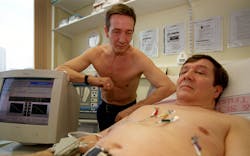Identical twins – a trucker and an athlete – show benefits of exercise
Identical twins – one an endurance athlete and the other a truck driver – have given researchers more insight into the age-old question of which is more important to overall health: nature or nurture. The results, while not conclusive because it only involved two specific people, indicate that our life choices, as opposed to our genetic makeup, may play a larger role in our health and lifespan.
Katie Bathgate, a lecturer at Cal State Fullerton, co-studied a 30-year history of the 52-year old men, and concluded that the twin who was the endurance athlete was healthier than his truck driver brother in terms of cholesterol levels, lung volume, triglyceride levels, blood pressure and blood sugar. The one area that surprised researchers was that the trucker brother had stronger leg and grip muscles.
"We're not sure why," she said. "His brother (driver) was carrying around a lot more fat mass. (He was classified as obese.) He's just carrying more weight throughout the day, so that could be a reason why." She added: "We just thought that because he was more active (the non-driver brother) that he would be stronger but that wasn't the case."
The most striking difference was in oxygen consumption. The active brother's VO2 max level was 23.8% higher than his trucker brother. VO2 max is the maximum amount of oxygen a person can utilize during intense exercise. It is seen as a measure of aerobic fitness. "This let us know that his heart is probably stronger… VO2 max can be an indicator of heart health."
Is it fair to compare someone who has devoted their adult life to running marathons and Ironman competitions to a twin who leads a more sedentary life? One twin was a high-school track coach, competed in long-distance races and logged almost 40,000 miles of running between 1993 and 2015. The trucker twin didn't do anything for training or exercise other than recreational sports in his early 20s.
Bathgate explains that the study was not about who was more fit, per se, but how well the body adapts to different lifestyles considering that the participants started out with the exact same genetic structure. In other words, the study indicated that we are not necessarily victims of our genes and the human body can become healthier with physical exercise. Our destinies are not carved in stone at birth.
Bathgate has some advice for truck drivers: "Physical activity does not have to be as vigorous as what our trained twin engaged in to reap benefits. Less vigorous physical activity has been shown to be related to better measures of health in twins (according to several other studies).
"The biggest takeaway is to get a mix of aerobic or cardiovascular training and strength training because both VO2 max and strength are independent predictors of mortality and health. If you are training aerobically, then you're going to get that adaptation such as your VO2 max. If you're training for strength, then you're going to get that strength adaptation. It's important to get a little bit of both."
She notes that looking at all twins' research as a whole this study is merely "a brick in the wall," a single, albeit important contribution. "We cannot solely blame our genetics for poor blood sugar levels, cholesterol, fat mass, cardiovascular fitness, and other measures of health. Lifestyle plays a fairly large role."
Bathgate offers exercise recommendations from the American College of Sports Medicine:
- At least 150 minutes of moderate-intensity exercise per week.
- Exercise recommendations can be met through 30-60 minutes of moderate-intensity exercise (five days per week) or 20-60 minutes of vigorous-intensity exercise (three days per week).
She adds: "This is a dose-response relationship. Even if you do not achieve the recommended amounts, 50 minutes is better than no physical activity and 100 minutes is better than 50. Also, it is recommended to gradually increase exercise time, frequency and intensity for best adherence and least injury risk."
You can read here the study, which was published in the European Journal of Applied Physiology.
About the Author

Larry Kahaner
Larry Kahaner is an author, journalist, and former FleetOwner contributor.
